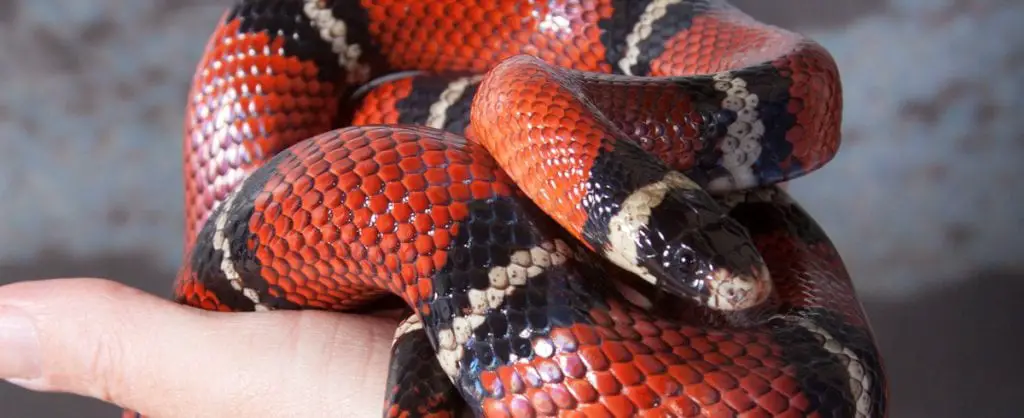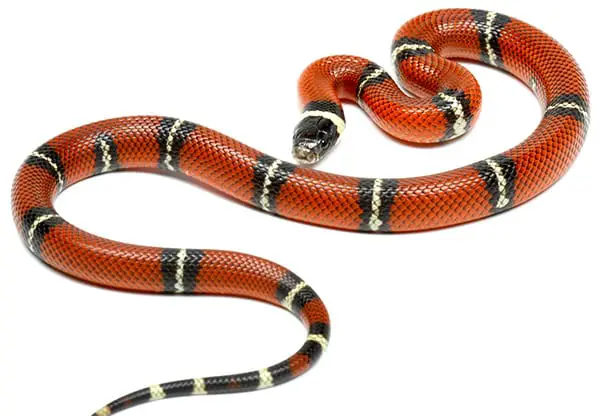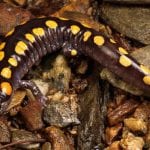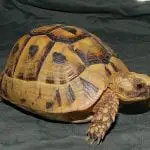Scientific Facts
| Common Name: | Sinaloan Milk Snake |
| Scientific Name: | Lampropeltis Triangulum Sinaloe |
| Life Span: | 12 to 20 Years |
| Length: | Up to 120 cm. |
| Clutch Size: | 4 to 16 |
| Habitat: | Semi-desert areas |
| Country of Origin: | Mexico |
Physical Description
The Sinaloan Milk Snake is a colorful snake species that is seen rarely during the day. Its color is consist of some broad red bands that are separated by some small black and yellow bands. Despite being viewed as milk-thirsty snakes, they are actually carnivores.
There are about 25 different subspecies of milk snakes that are recognized all throughout the entire geographic range. All these subspecies come with slight variations in terms of color. Sinaloan Milk Snakes feature the characteristics mentioned earlier, making them similar in appearance to other subspecies, such as coral snakes that are also found in the same range.
Sinaloan Milk Snakes are not venomous, though their bright colors serve as a false advertisement to possible predators. Many subspecies, including Sinaloan Milk Snakes, feature aposematic mimicry, which means that their color patterns are similar to those of other venomous species, such as coral snakes and copperhead snakes.
The red rings in the body of the snakes are bordered towards the edge of their ventrals with black pigment, thus leaving the middle of the triad with a creamy white side. It can be distinguished easily from other snake subspecies because of their really broad red bans, which are obviously more prominent compared to that with other subspecies. The head of a Sinaloan Milk Snake is also black, with a cream-colored band right behind their eyes, on top of their head. They have a creamy white belly.
Native Habitat
Sinaloan Milk Snakes are generally found in Mexico, especially in the states of Sinaloa, Sonora, and Chihuahua. They thrive in arid, dry, and rocky semi-desert areas. At daytime, they usually rest under loose rocks, beneath cactus plants or rock crevices. They are also found in some areas where humans reside, typically finding refuge in woodpiles and barns.
Etymology
The common name, Milk Snake, came from an idea that these snakes milked cows. The possible start of this myth was back when farmers sought alibis as to why their cows produce less milk than usual. The milk snakes were convenient culprits as they are usually drawn to the mice inside the barn. Of course, snakes do not consume milk, as they are generally carnivorous.
Behavior
Sinaloan Milk Snakes are solitary, and they are seen rarely in the daytime. They can be spotted crossing streets at night. They usually stay hidden under damp trash or rotting logs. They are found in groups only during the hibernating season. Before and after hibernating, they are observed basking in the sun together.
When these snakes are threatened, they usually vibrate their tail, thus creating a sound similar to the sound produced by rattlesnakes. They also produce a pungent musk from their cloaca, serving as a warning. This helps in deterring some predators.

Temperament and Handling
Generally speaking, all milk snakes, including Sinaloan Milk Snakes, have the tendency to be slightly more skittish compared to other snakes that are recommended for beginners. Still, they are docile and quite easy to handle. They usually become more confident as they continue to age. They are quite reluctant to biting, with musking as their main mechanism for defense.
They are also highly active, which is why it is recommended to keep an eye on them always when holding them. When you get your snake for the first time, make sure to give it some time to get acclimated to its new environment. This is important before even trying to attempt handling it.
The snakes should already be eating before holding them. Give it about seven days before starting to handle it. Wait for another 48 hours after they eat before handling them again.
Housing
Being an aesthetically attractive and big milk snake, Sinaloan Milk Snakes are among the most popular species for beginners. The reason behind this is because these snakes are quite easy to care for. The snakes need to be kept individually due to the risk of the larger snakes eating the smaller ones. This is a tendency for this species.
Sinaloan Milk Snakes are generally sedentary. Even large adults can be housed comfortably inside a 20-gallon terrarium, or a plastic box with a substrate. For the substrates, shredded aspen in a preferred option or similar bedding, which helps in maintaining humidity.
Provide a bowl of clean water and change it regularly. While these snakes do well at any temperature, but it has been observed that a temperature of about 75 to 85 degrees Fahrenheit is the ideal range. They do not need a temperature drop at night time.
You may also want to install an under tank heating pad in the corner of the terrarium, with a temperature set at 90 degrees Fahrenheit. Even though they do not really need it, many species naturally learn to bask under a basking lamp. Most snakes are easy to handle, though some may be nippy when feeling nervous.
Even the hatchlings are quite easy to feed. They thrive on small mice a few days after they hatch. Larger adults eat small rats and adult mice. They can be fed once or twice a week. They are mainly nocturnal in the wild, though captive-bred snakes can take food given at any hour. These snakes can be messy at times, so make sure to wipe their feces off the surfaces of the glass.
Longer snakes obviously need bigger enclosures. This will allow your pets to be able to stretch fully. Just like most colubrids, these snakes are very active, and thus, should be given enough space to explore and roam around. It is preferable to prepare a front-opening vivarium compared to a top-opening one. Make sure that the cage is absolutely escape-proof.
Once your enclosure is completely set up, one thing that you need to remember is keeping cleanliness. Poor living conditions may lead to infections as well as other health problems. Aside from making sure that the water is replaced on a regular basis, making sure that the enclosure is clean all the time is as equally important. This also includes cleaning the substrate chosen and the hides. Clean the enclosure lid and sides periodically to prevent the possible build-up of bacteria.
Substrate Options
Aside from the options that are mentioned above, other possible options include orchid bark, kiln-dried pine, cypress mulch, as well as coconut husk. Aspen shavings may also be used provided that humidity stays on the low end, preferably at 30 to 40%.
Preparing a 2:3 ratio combination of playsand and organic soil proves to be a natural choice. This can also be used for bioactive setups. Using a loose substrate will also allow the snakes to burrow, though paper towels are also good options to use during the quarantine.
From time to time, your pet will need to retreat from others, going to a suitable hide. If hides are absent, the snakes can become stressed. There are commercial hides that can be purchased, though as an alternative, you can compromise using a cardboard box, or one that is similar.
An important thing to note is that your snake has enough access to entering the hide when it wants to and that the hide is not too big. In fact, it should just be enough space for your snake to feel safe and curl up. If the hide is too large, the snake may not feel too secure, and may not feel confident settling well.
A loose layer of substrate that is a few inches in thickness encourages burrowing. Two hides need to be prepared, one on each side. One should be placed on the cooler end and another one on the warm end. This will also ensure that the snake thermoregulates, or control its temperature. It also serves the purpose of providing security to your pet.
You also have the option to add the third hide. This can be useful during the shedding process, though not really mandatory. Covering the three sides of the pets’ enclosure helps them to feel more relaxed as they explore their surroundings.
Sinaloan Milk Snakes are also good climbers, so dowelling or branches can be installed to give them want they want. Climbing will also help them exercise. These branches need to be securely fixed and should be sturdy enough to take the weight of your snake. When preparing the branches, it is good to try them out first by pressing lightly on them, making sure that there is no way that your snake will topple over and fall off the branches.
Heat
Most subspecies of Milk Snakes thrive really well in a temperature range of 75 to 85 degrees Fahrenheit. In order to create a basking spot with a temperature range of 85 to 92 degrees Fahrenheit, an incandescent spotlight can be used.
Big enclosures are a requirement if a thermal gradient is to be created. Thermal gradients are important to your pets’ health, allowing them to naturally regulate the temperature of their body by moving from a warm to a cool area. An under-tank heat pad, a ceramic heater, or a night bulb can also be used in providing the needed heat at night time.
Milk snakes, in general, are cold-blooded animals, which means that they cannot produce or regulate their own body temperature. They need to soak in the heat of their environment in order to become active. This should be provided by keepers.
It is often not a good idea to heat the entire enclosure, as they also have to cool down when they feel too warm. When using a heat mat, it should be placed about halfway beneath the enclosure. Lowering the temperature below the recommended range may make your snake somewhat sluggish. In the long run, it may even affect their overall health.
Using a light bulb controlled using a thermostat can be just as effective though the bulb has to be situated inside the housing. With this, a suitable guard needs to be fitted in order to make sure that there is no possibility of your pet injuring itself by getting burnt or climbing on the bulb.
The use of light bulbs can be considered as a cheap alternative when replicating daylight and nightlight patterns. It may also be needed to connect the bulb to a dimmer switch, ensuring that the lighting is reduced as hours pass by without losing too much temperature. You can also add a reliable yet small thermometer inside the enclosure so that you can be assured of the appropriate temperature every time.
Humidity
These snakes like their enclosure to be humid, but at the right level. The level should not be as high as with other reptile species, and the atmosphere should never reach a point that is too dry. Adding a water bowl will help with this, though occasionally spraying or misting them will also help. While it may not be necessary to add a humidity meter, but it may be good if you are a beginner.
Food and Diet
These snakes are described as opportunistic predators. They can consume anything that they can find, including lizards, reptile eggs, other snakes, birds, amphibians, and small mammals, like rodents. They usually overpower their prey by constriction. Just like other species of kingsnakes, they have a certain immunity to the poison of venomous snakes that they eat.
Most adult Sinaloan Milk Snakes are happy to accept pre-killed mice. Hatchlings can typically eat newborn mice of smaller species. In the wild, these young snakes primarily feed on frogs, small lizards, as well as insects. Scenting a pinkie them with these foods can encourage even reluctant feeders.
Juveniles eat a pinkie once every few days. Other specimens, however, may feed on adult rats or mice but only need to eat once a week maximum. Unless you are personally breeding rodents, it is recommended not to feed them with wild food as they may be a source of diseases or parasites.
As a general rule, offer prey food that is around the same size as the thickest part of your snake, or slightly bigger than the mid-body of your snake. Last, make sure that your pet will always have access to fresh and clean drinking water all the time. Also, make sure to feed them inside their enclosure in order to prevent stress, bites as well as regurgitation. Among their common predators include raccoons, skunks, cats, dogs, owls, and hawks.
Another warning from keepers is to avoid handling the snakes right after feeding them. The idea is similar to the advice of avoiding picking up babies after they eat. The snakes can regurgitate the food they just ate. You may start handling or lifting your snake after a couple of hours, thus allowing the food to pass.
If you notice your snake regurgitating on its meal regularly, it may be best for you to seek advice from a veterinary surgeon as your snake may have some digestive issues. If the regurgitation happens, but rarely, the problem may be that your pet has had difficulty swallowing the meal you have prepared. This means that it should not be fed again. It is often best to wait for another week for another feeding schedule.
Digestive issues can also be observed with a sudden weight loss or a sudden change in the behavior of your snake. For this reason, it is very important to know your snake really well, observing its usual behavior so that you can easily spot anything that is out of the usual.
Water
It is a requirement for Sinaloan Milk Snakes to have a bowl of fresh and clean water. The dish should be large enough, not just for them to drink, but also to soak in if possible. There is no need to prepare an actual food bowl, as a lid of a container is enough during feeding. This will also help in avoiding the substrate from being consumed.
Aside from drinking, your snake will use the water bowl for bathing as well. Because of their habit of soaking in water, the bowl should be shallow enough because of the risk of your snake toppling the bowl over or even drowning if the bowl is too deep. The water should be replaced at least every two days as the feces of your pet may be deposited in the water, quickly fouling it and deteriorating its freshness.
Companions
Many species of milk snakes favor other snake species as food. They are even known to be notorious cannibals. The hatchlings are particularly challenging to care for in groups, but adults are observed to “sample” their cage-mates, even those that they have already lived with for several years.
Sinaloan Milk Snakes are best kept separately and need to be carefully watched when paired for breeding. Individuals that are housed together need to be separated while feeding, and this is usually when accidents happen.
Development and Reproduction
The breeding season for Sinaloan Milk Snakes is from May to June. During this mating season, they use chemical clues, exhibiting behaviors common during courtship. Male snakes contact females using their head, flicking their tongues and jerking their bodies to start a courtship.
Whenever possible, males display these behaviors when in contact with females, but flicks their tongue at the ground if the female snake moves away. Then, the male starts to advance on the female in a dorsal pose, and the female jerks forward. After, the male will then start to wrap the female loosely, positioning himself for copulation.
Around 1 to 1 and a half months after mating, the female will lay around 4 to 1 eggs. A succeeding clutch may also be laid in as little as 44 days. The eggs go through incubation period for about 2 to 2 and a half months, later emerging hatchlings, which measure about 25 to 30 centimeters.
Breeding
To breed Sinaloan Milk Snakes, a male and a female snake is needed for mating. The preparation for breeding often starts a few months before the actual event when the snakes go through a period of semi-hibernation, or brumation.
The female snakes send out an odor that will attract the males. The time for actual mating may vary depending on the specimens. It usually ranges from a few minutes to a few hours. In order to ensure that fertilization takes place, many snake keepers keep the two snakes together until they have successfully mated several times.
When successful, the female snakes will bloat, and the gestation is usually up to a few weeks. During this time, you can start preparing for a place for the female snake to lay her eggs. It can be a plastic container that is big enough for the snake to enter.
How to Care for a Sinaloan Milk Snake
These snakes are very easy to care for in captivity. Any keeper, regardless of experience, will surely love caring for these snakes. Given that you can meet their few and simple needs, you can be assured that your snake will survive a healthy and long life.
When it comes to preparing the cage of your snake, a general rule of thumb is that more space is better for adult Sinaloan Milk Snakes. This will allow them to get their much-needed exercise. It is also recommended to install some hides inside the enclosure, one on each side. Other decors can also be added, including vines, tubes, branches, and plants. This will not just add further security to the housing, but also encourage them to climb.
A substrate that will permit burrowing is often a good idea for these snakes. In the wild, these snakes are very secretive, hiding beneath things, burrowing for refuge and safety. As much as possible, this behavior should be duplicated even in captivity. The more closely you copy the natural environment for them, the healthier they will become in captivity.
Where to Find Sinaloan Milk Snakes
There are different sources of Sinaloan milk snakes. They are usually available from pet stores that specialize in selling these species of snakes. You can also get them from small local breeders in the area. The latter option is often preferred by keepers because of the assurance of the quality of the snakes, rather than getting snakes from chain pet stores, as well as mass-scale breeders.
FAQs
What do Sinaloan Milk Snakes eat?
Just like other species of milk snakes, the Sinaloan Milk Snakes are nocturnal, which means that they usually eat after dark. They are known to consume a wide variety of animal food, including eggs, rodents, reptiles, birds, invertebrates, as well as amphibians.
Are Sinaloan Milk Snakes venomous?
These snakes are not venomous. However, their bright colors can be confusing to their potential predators. They are observed to exhibit aposematic mimicry, which means that their color patterns resemble those of other venomous snake species, including coral snakes and copperhead snakes.
Why are they called milk snakes?
The name Milk Snakes was given in general because there was a time when people believed that they sucked milk from cow udders. This is impossible anatomically for the snakes, as they do not have lips. This will also not be tolerated by the cows.
Do Sinaloan Milk Snakes have teeth?
Milk snakes, in general, have small and hooked teeth, instead of having fangs. Even though a bite from these snakes may hurt, getting bitten will not cause some serious harm.
Where do Sinaloan Milk Snakes live?
They thrive in different kinds of habitats. However, they are usually found near the edges of forests, as well as in open woodlands, grasslands, and prairies near rivers and streams. They can also be found on rocky hillsides, farmlands, and other suburban areas.
Do Sinaloan Milk Snakes make good pets?
Sinaloan Milk Snakes have recently gained popularity as pet snakes. Size-wise, they are small enough to be placed in a standard-sized enclosure. They are also big enough to be pleasurable to look at. Most subspecies also thrive well in captivity and are happy to eat frozen and thawed rodents as part of their regular meal.
Do Sinaloan Milk Snakes bite humans?
Even though they are not likely to attack, Sinaloan Milk Snakes are non-venomous. They will not cause much damage when discovered.
How long do Sinaloan Milk Snakes live?
The lifespan of these snakes in the wild is unknown. However, in captivity, they can live up to 12 to 20 years.
Are Sinaloan Milk Snakes good for beginners?
As pets, Sinaloan Milk Snakes are easy to care for. They are non-venomous and of good size. They need an enclosure with light and heating at a specific temperature and humidity that is highly dependent on the subspecies. While they may be challenging to handle because they find that humans can be threatening, but their bites are not painful.
How big do Sinaloan Milk Snakes get?
Fully grown adult Sinaloan Milk Snakes can reach a length of about 120 cm or more.



